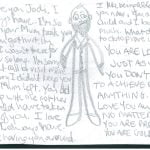This exercise helps you to learn how to talk nicely to yourself when you do something you’re not very happy with yourself about. Instead of criticising yourself it shows you how to think self-forgiving thoughts. You don’t need to scold or punish yourself when you do something in a lesser way than you’d like. You can actually choose to be compassionate to yourself instead – it’s up to you!!
In this exercise, you create a set of columns and rows – a matrix (as outlined below). Then you use this matrix to reorient your thoughts and feelings from self-attacking thoughts to self-forgiving thoughts. An example showing how the process works is included below.
Here is the format:
|
Distressing Situation
|
Distressing Feelings
|
Self-Attacking Thoughts
|
Self-Forgiving Thoughts
|
Example
A few seconds ago, I knocked a cup of coffee onto my computer. For me, that counts as a distressing situation. Therefore, it’s a good experience to plug into the matrix. Here is how I began to fill in the boxes.
|
Distressing Situation
|
Distressing Feelings
|
Self-Attacking Thoughts
|
Self-Forgiving Thoughts
|
|
I spilled my coffee onto my computer
|
Frustration
Guilt
Nervousness
|
|
|
In the first column, I simply describe the situation. In the second column, I make a list of some of my feelings: in this case, frustration (with myself), guilt (about my mistake), and nervousness (about the repercussions of the situation). I find it helpful to make this feeling list. By naming our specific feelings, we bring them up into awareness. We take ourselves out of denial. We reduce the tendency to ‘squash things down’.
Next, we use our feelings to move on to the underlying thoughts. The relationship between feelings and thoughts is like the relationship between smoke and fire. Distressing feelings are the smoke. Distressing thoughts are the fires that give rise to the smoke. In this case, where there’s smoke, there is fire – where there are distressing feelings, there are distressing thoughts underneath. In column three, we uncover the thoughts that are fuelling the feelings. Here is what I came up with.
|
Distressing Situation
|
Distressing Feelings
|
Self-Attacking Thoughts
|
Self-Forgiving Thoughts
|
|
I spilled my coffee onto my computer
|
Frustration
Guilt
Nervousness
|
That was such a dumb thing to do. I should be more careful. My computer is probably going to break now, and it’s all my fault. I’ll probably have to pay a lot of money to fix it. People are going to laugh at me if they see how careless I am.
|
|
As you can see, I uncovered three sets of self-attacking thoughts in column three. I probably could have come up with many more – but these were a good start. Writing them out in the matrix was extremely helpful. To be honest, I wasn’t even aware of these thoughts until I wrote them out. As I filled in this third column, the key was to realise that my feelings (in column two) were coming from my thoughts (in column three), not simply from the situation. You could say that the situation was a ‘trigger’ for the thoughts. I’m certainly not glad that I spilled coffee on my computer. But it was the thoughts that I needed to work on now.
Let’s move to column four – the heart of this exercise. In the final column of the matrix, you substitute self-forgiving thoughts for each of the self-attacking thoughts in column three. This is the big step. This turns the mind from self-criticism to self-forgiveness; from distress to peace. As you do this, you can focus on simply moving in the right direction. You don’t have to take a huge leap into complete forgiveness; you can take a series of little steps. Every bit of progress is helpful. Here is what I came up with, as I made this substitution.
|
Distressing Situation
|
Distressing Feelings
|
Self-Attacking Thoughts
|
Self-Forgiving Thoughts
|
|
I spilled my coffee onto my computer
|
Frustration
Guilt
Nervousness
|
That was such a dumb thing to do. I should be more careful. My computer is probably going to break now, and it’s all my fault. I’ll probably have to pay a lot of money to fix it. People are going to laugh at me if they see how careless I am.
|
It wasn’t a dumb thing to do; it was simply an accident; And besides – my worth isn’t dependent on how ‘careful’ I am. Actually the computer seems fine. But even if I do need to repair the computer, I can do that in a self-forgiving state of mind. If people laugh at me, that’s their problem. Everyone makes mistakes at times.
|
Those self-forgiving thoughts may not have been the ‘highest’ thoughts in the world, but they helped me to shift my mind toward a more self-forgiving space. As I did that, the feelings of frustration, guilt, and nervousness were replaced – to some degree – by a greater sense of peace and self-acceptance. That is the goal of this exercise.
I find that this ‘cognitive restructuring’ work – replacing self-attacking thoughts with self-forgiving thoughts – is like priming a pump. We locate our self-attacking thoughts, and replace them with self-forgiving thoughts. We do this mechanical work over and over until the flow of loving, forgiving thoughts begins to run on its own. There is some work to do at the beginning, but we’re simply preparing our minds to receive the divine flow.
Conclusion:
Use this exercise whenever you catch yourself thinking self-attacking thoughts. Change them into self-forgiving thoughts. Over time you will find that your thinking automatically becomes self-forgiving whenever you do anything you are not 100% happy with yourself about. It will eventually become habit.
(This exercise comes from: Joseph D, 2004, The Matrix, Living Now, September 2004, Queensland issue 66, p22)
Your turn
|
Distressing Situation
|
Distressing Feelings
|
Self-Attacking Thoughts
|
Self-Forgiving Thoughts
|
|
|
|
|
So breathe into your heart. Visualise golden light awakening and enlivening it and let that light shine forth – soothing and awakening all souls you come in contact with. Spread love and light wherever you go and you will be a powerful servant of God – without even uttering a word.









